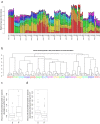A robust ambient temperature collection and stabilization strategy: Enabling worldwide functional studies of the human microbiome
- PMID: 27558918
- PMCID: PMC4997331
- DOI: 10.1038/srep31731
A robust ambient temperature collection and stabilization strategy: Enabling worldwide functional studies of the human microbiome
Abstract
As reports on possible associations between microbes and the host increase in number, more meaningful interpretations of this information require an ability to compare data sets across studies. This is dependent upon standardization of workflows to ensure comparability both within and between studies. Here we propose the standard use of an alternate collection and stabilization method that would facilitate such comparisons. The DNA Genotek OMNIgene∙Gut Stool Microbiome Kit was compared to the currently accepted community standard of freezing to store human stool samples prior to whole genome sequencing (WGS) for microbiome studies. This stabilization and collection device allows for ambient temperature storage, automation, and ease of shipping/transfer of samples. The device permitted the same data reproducibility as with frozen samples, and yielded higher recovery of nucleic acids. Collection and stabilization of stool microbiome samples with the DNA Genotek collection device, combined with our extraction and WGS, provides a robust, reproducible workflow that enables standardized global collection, storage, and analysis of stool for microbiome studies.
Figures





References
Publication types
MeSH terms
Substances
LinkOut - more resources
Full Text Sources
Other Literature Sources
Research Materials

